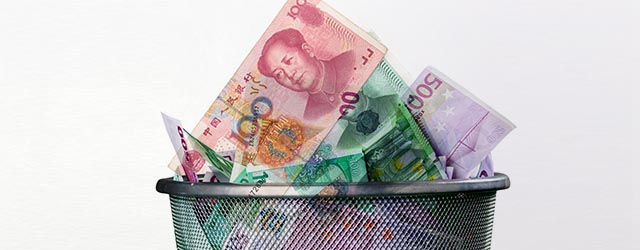The renminbi’s entry into the International Monetary Fund’s basket of currencies, the Special Drawing Rights (SDR), will require China to have a more flexible exchange rate.

A Tale Of Two Baskets
The People’s Bank of China (PBOC) will achieve this flexibility by managing the renminbi against a trade-weighted currency basket, rather than pegging the currency to the dollar.
To establish the renminbi in the SDR in October 2016, central banks will need to buy between $30 billion and $42 billion of renminbi assets, analysts say. China doesn’t want all of this buying to push up the value of the currency.
With its new basket, Chinese authorities have found a way to weaken their currency while anchoring market expectations in an effort to avoid a market shock similar to that of last August’s stock market crash, according to a BofA Merrill Lynch Global Research report. With the Chinese economy slowing, the PBOC is losing reserves, and monetary policy has proved unable to loosen monetary conditions in China, the report states. By easing the yuan’s peg to the dollar, China will be able to benefit from a weaker renminbi as the Federal Reserve tightens monetary policy, states BofA.
Julian Jessop, chief global economist at Capital Economics, says: “The PBOC statement said its new currency index will be ‘of great significance in changing how the world looks at the renminbi.’ This seems to be a strong hint that the markets should expect any further strength in the US currency against those of China’s main trading partners to be at least partly offset by a decline in the renminbi against the dollar.”
Capital Economics expects the PBOC to keep the renminbi broadly stable against its new, 13-currency basket in the months ahead. There could be a further fall of about 5% in the renminbi against the dollar in the year ahead, it says. A bigger fall would clash with China’s aim of promoting the renminbi as a strong global reserve currency, says Jessop. Jan Dehn, head of research at Ashmore Investment Management, says: “The adoption of a currency basket should allow China to move more quickly to a flexible exchange rate and is entirely consistent with the stated objective of the renminbi’s formal inclusion in the SDR. China’s trading partners are global, not just the US.”
The IMF itself has suggested that the move to a currency basket could be a good transitional step toward a fully liberalized Chinese currency.
The weight of the dollar in the new basket will be 24.6%, or 30% including the Hong Kong dollar, which is pegged to its US counterpart. The euro and the Japanese yen will have weights of 21.4% and 14.7%, respectively.
“The US dollar is arguably entering bubble-like valuations, while China’s policymakers tend to take longer-term views and, therefore, prefer FX policies that are more sustainable and therefore stable over the longer term,” Dehn says.
Jessop of Capital Economics says that if he is wrong and the renmbini does fall a lot further, the global fallout will almost certainly be negative. It might set off a downward spiral as other currencies seek to maintain competitiveness, he says.



